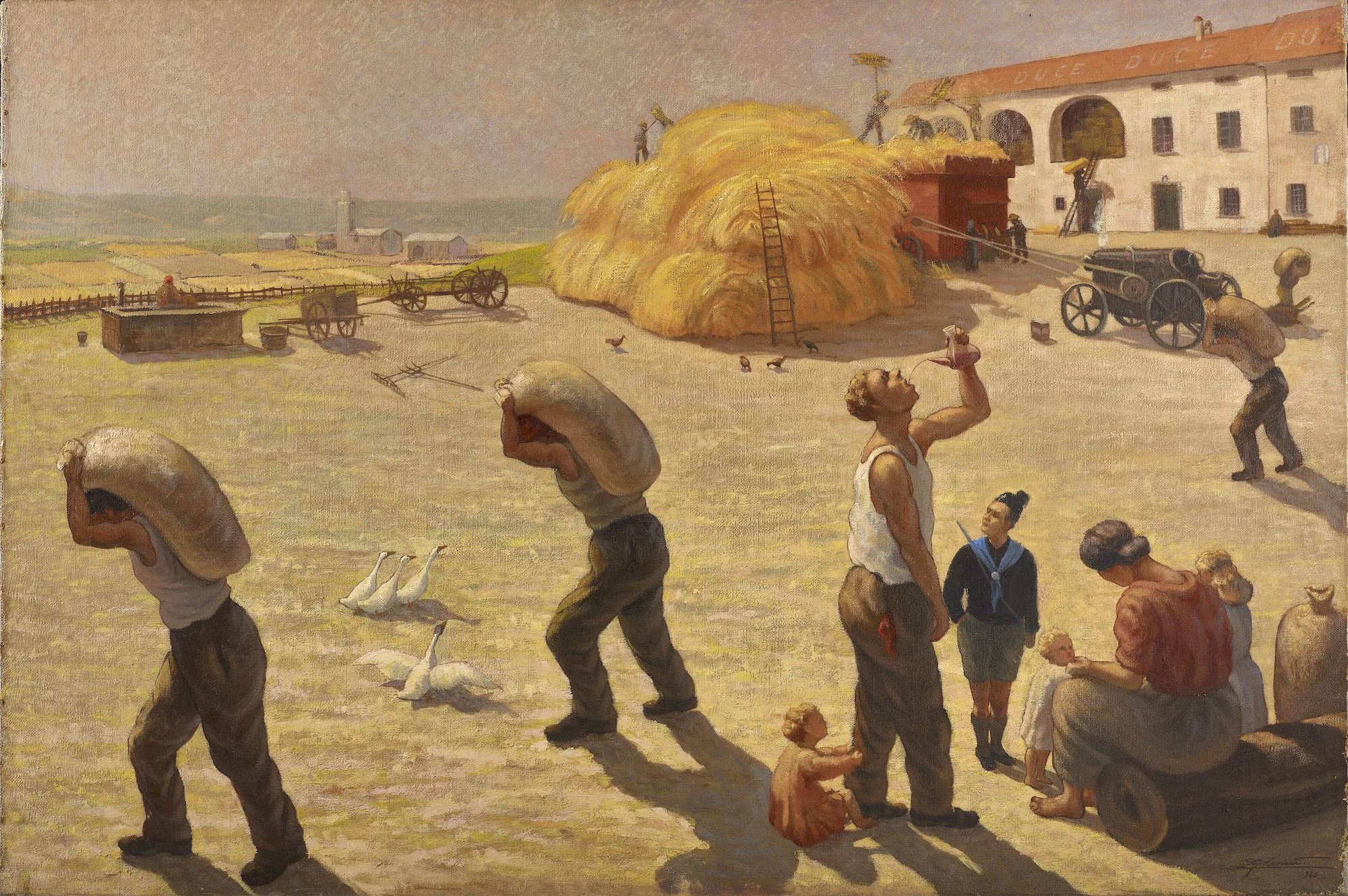
Wolfsonian-FIU photo

Audio By Carbonatix
What’s the first thing that comes to mind when you hear the word “landscape painting”? Perhaps it’s a pastoral scene from the English countryside, something by John Constable or Thomas Gainsborough. Maybe it’s a scene from the American West, a Monument Valley picture worthy of a John Ford cowboy classic. Or perhaps it’s one of Claude Monet’s iconic impressionist works.
All of these are conventions that the Wolfsonian-FIU in Miami Beach wants to dispel in the design-focused museum’s latest exhibition. “The Big World: Alternative Landscapes in the Modern Era” is about changing our ideas around one of the most well-known genres of art. But instead of gardens and farmland, we see cityscapes and industrial scenes, workers laboring on farms and in factories, and even scenes of war and turmoil.
“Our collection contains a lot of materials relating to urbanization, to industrialization, to the expansion of the built landscape,” says Lea Nickless, who curated the show with the Wolfsonian’s chief curator Silvia Barisione.
“The Big World” opens on Thursday, September 21, and runs through June 2, 2024.
Will you step up to support New Times this year?
At New Times, we’re small and scrappy — and we make the most of every dollar from our supporters. Right now, we’re $18,000 away from reaching our December 31 goal of $30,000. If you’ve ever learned something new, stayed informed, or felt more connected because of New Times, now’s the time to give back.
The two conceived of the show as a way to make do with limited space and resources, while the museum building remains only partially open due to renovation. They drew from the institution’s existing collection, featuring art and objects dating from 1850 to 1950, and its idiosyncrasies were a factor in determining the show’s concept and focus. Mickey Wolfson, the museum’s founder, didn’t collect popular genres like impressionism, the “big revolution in landscape painting,” according to Barisione, which was defined by “plein air” pictures of outdoor scenes. What the museum could draw on were movements like futurism and Art Deco that emphasized the way the world was being changed by human activity.

La bataille pour la ville (The Battle for the City), 1944. Raymond Daussy (French, 1918–2010) Paris. Oil on canvas.
Wolfsonian-FIU photo
“It’s really kind of interesting to see artists and designers responding to these changes with, almost a kind of elation in many cases,” says Nickless. “I think it’s ironic, in a way. You’re looking back and seeing how these visions are being used.”
The show is split into three sections in roughly chronological order, which takes into account the move from the agrarian and rural to the industrial and urban. “The Natural World” starts with traditional sountains, forests, and farmland. scenes Soon, in “The Built Environment,” industry begins to take over, and the wild landscapes are replaced with factories, skyscrapers, and cityscapes. Barisione, in particular, refers to one painting by Norman Wilkinson, showing a power station with massive smokestacks rising above a riverbank.
“I see them as the new monuments in the landscape,” says Nickless.
The show also does away with the idea that a proper landscape has to be a flat, two-dimensional image. Plenty of other objects feature in the show, demonstrating the genre’s use in applied arts and design. The biggest and most impressive is a Baldwin baby grand piano created for the 1904 World’s Fair in St. Louis, carved ornately from mahogany by Clement J. Barnhorn and featuring side panels painted by Joseph Henry Gest. There are a few ceramics, including a George Schreiber vase depicting Manhattan skyscrapers and an ornate Wedgwood vase with a Chinoiserie dragon-and-temple motif.

American Art Piano, 1904. For the 1904 St. Louis Louisiana Purchase Exposition, Joseph Henry Gest (American, 1859–1935), painter Clement J. Barnhorn (American, 1857–1935), sculptor Baldwin Piano Company, Cincinnati, Ohio, manufacturer Mahogany, paint, metal, ivory.
Wolfsonian-FIU photo
The Wedgwood take on Oriental themes contrasts well with an object of actual Asian origin, one with a much darker subtext: an ornately painted black kimono from Imperial Japan depicting the invasion of Manchuria. Part of the Wolfsonian’s collection of propaganda kimonos, it features a soldier on a white horse waving the Japanese “Rising un” flag, today considered a symbol of the country’s militarist past equated by some with the Nazi swastika. Several other objects in the show feature political undertones, from Works Progress Administration murals to a souvenir plate showing Adolf Hitler’s Bavarian chalet. Nickless says the museum aims to encourage people to explore the intent behind these artworks.
“That’s another layer that, when you’re looking at each of these images, you kind of have to try and figure out a little bit. Like, okay, what was the purpose of this image? Was it used to promote an idea? To promote an agenda? Is it the underlying message of a national entity or a corporate entity?”

The City, 1936, Virginia Berresford (American, 1904–1995) New York City, Oil on canvas.
Wolfsonian-FIU photo
The show’s third part, “The Battle for the Land,” perhaps feels the most relevant to our era. Artists began to contend with the dark side of industry and progress, the continent-spanning wars that dominated the early 20th Century. Artists like Raymond Daussy depict cities in ruins; others show the effects of human progress on the surrounding landscape. One by Virginia Beresford shows a man looking upon a gnarled, dead tree amid a barren field, skyscrapers rising in the distance behind it.
“Our founder Mickey Wolfson was always looking at the iconography of the defoliated tree,” says Nickless, “how it’s almost a symbol of the degradation of the land.”
– Douglas Markowitz, ArtburstMiami.com
“The Big World: Alternative Landscapes in the Modern Era.” On view Thursday, September 23, through Sunday, June 2, 2024, at the Wolfsonian-FIU, 1001 Washington Ave., Miami Beach; 305-531-1001; wolfsonian.org. Tickets cost $8 to $12; admission is free for Florida residents.